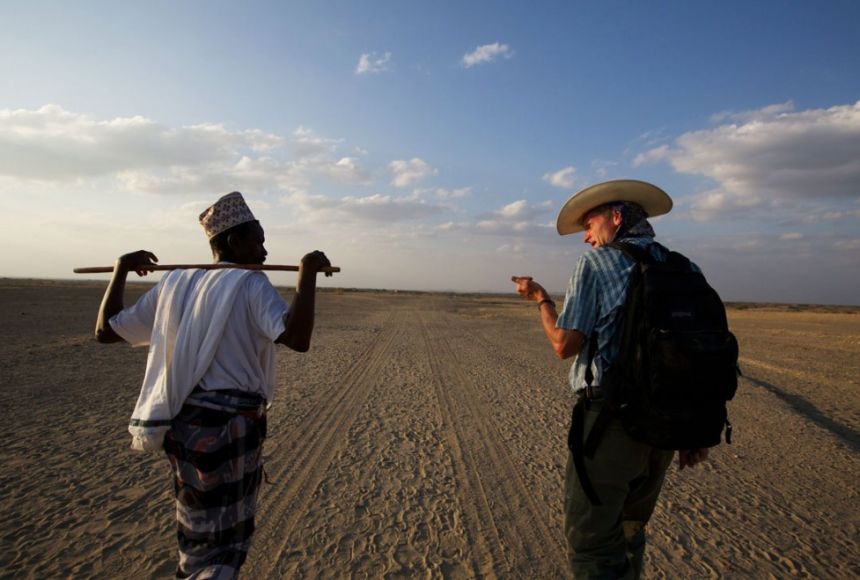About 60,000 years ago, the earliest humans left Africa, some scientists think. Journalist Paul Salopek wants to follow in their footsteps.
In 2013, Salopek set out on a very long walk. It will last at least 10 years. He has named this trip the Out of Eden Walk. His route will take him from the African country of Ethiopia to the Middle East. He'll head through Central and Southeast Asia. Then, he will go to North America.
Long ago, there was a land bridge that connected Asia and North America. Some of our ancestors used it to cross continents. The land bridge has long since disappeared, so Salopek will take a ship instead. He will cross the Pacific Ocean. He will then walk along the West Coast of the United States and Mexico. He will cross Central America to South America. He'll walk along its western coast to the southernmost tip of the continent. Just as some our ancestors did, Salopek will travel mostly along oceans and seas.
As he walks, Salopek is going to be documenting the places he travels and the people he meets. Salopek is also telling the stories of the past, from the earliest humans to more recent times. Some of the places he has walked through have clues that can help us understand early humans.
In the Beginning
Salopek chose Herto Bouri, Ethiopia, for the starting point of the walk. This desert site is the location of the 160,000-year-old Herto man fossil. These human remains are believed by many scientists to be the oldest ever found.
Herto man is proof that modern humans lived in Africa at least 160,000 years ago. Evidence shows these modern humans did not leave Africa until between 60,000 and 90,000 years ago. Most likely, a change in climate pushed them out. Experts suggest that too little rain in that part of Africa led to starvation. Humans were driven to near extinction. They had to find better climate and greener lands, so they went to the Middle East.
Food Is Life
Finding and preparing food was very important for our human ancestors. It isn't surprising that they made tools for this. Gona is an old site in Ethiopia. It is covered with ancient tools. Some are nearly three million years old.
Modern humans are known as Homo sapiens. Before us, there were different, earlier types of humans. We all belong to the same group, called hominins. The tools found at Gona used to be crude, sharp objects. They weren't made by modern humans such as Herto man. Instead, they were made by an earlier kind of hominin.
Scientists think early humans in Gona were scavengers. They searched for food. Then they used their tools to cut up meat and bones. It is likely that most of their food was plants.
Settling Down
Early humans were hunter-gatherers. They moved often and looked for food. About 10,000 to 13,000 years ago, something changed. In a valley in the state of Palestine, some humans settled in one place. They created tools to harvest grains. Eventually, they began to grow food. The concept of farming was born.
New Understandings
Dmanisi is a town in the country of Georgia. The town is between Europe and Asia. It has been a popular crossroads for almost two million years. The evidence is in layers underground. The top layer has 1,400-year-old remains of the ancient city of Dmanisi. Below that are the remains of a 5,000-year-old settlement. And below that? The 1.8-million-year-old fossil remains of one of our early ancestors. These ancestors are known as hominins. The ones in Dmanisi are one of the earliest hominin remains found outside of Africa.
Salopek visited the nearby National Museum to see these remains for himself. The Dmanisi skulls changed how scientists understand human evolution. The theory of evolution states that life forms, from animals to plants, change over millions of years. With time, species will die out or lead to new species.
The Dmanisi fossils showed a mixture of features from three different hominin species. These helped scientists to better understand how these species related to each other.
One of the skulls showed the earliest evidence of caring behavior. The skull belonged to an older man. His jawbone showed that he had only one tooth while he lived. Almost two million years ago, he would not have been able to survive on his own without teeth. Yet, his bones show that he lived for years after losing them. This tells scientists that someone helped take care of him.
Something in Common
The Out of Eden Walk will take Salopek 33,796 kilometers (21,000 miles). He will cross five continents and more than 30 countries. Along the way, he will come across many different languages and ways of life. Yet, everyone he talks to will have something in common. They can all trace their family tree back to Africa.

